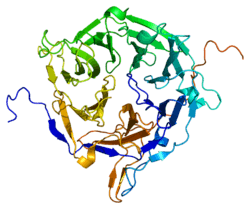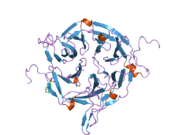Nucleoporin 214
Nucleoporin 214 (Nup2014) is a protein that in humans is encoded by the NUP214 gene.[1][2][3]
The nuclear pore complex is a massive structure that extends across the nuclear envelope, forming a gateway that regulates the flow of macromolecules between the nucleus and the cytoplasm. Nucleoporins are the main components of the nuclear pore complex in eukaryotic cells. This gene is a member of the FG-repeat-containing nucleoporins. The protein encoded by this gene is localized to the cytoplasmic face of the nuclear pore complex where it is required for proper cell cycle progression and nucleocytoplasmic transport. The 3' portion of this gene forms a fusion gene with the DEK gene on chromosome 6 in a t(6,9) translocation associated with acute myeloid leukemia and myelodysplastic syndrome.[3]
Interactions
NUP214 has been shown to interact with NXF2,[4] ZFP36[5] and NXF1.[4][6]
References
- ↑ Kraemer D, Wozniak RW, Blobel G, Radu A (March 1994). "The human CAN protein, a putative oncogene product associated with myeloid leukemogenesis, is a nuclear pore complex protein that faces the cytoplasm". Proc Natl Acad Sci U S A 91 (4): 1519–23. doi:10.1073/pnas.91.4.1519. PMC 43191. PMID 8108440.
- ↑ von Lindern M, Poustka A, Lerach H, Grosveld G (August 1990). "The (6;9) chromosome translocation, associated with a specific subtype of acute nonlymphocytic leukemia, leads to aberrant transcription of a target gene on 9q34". Mol Cell Biol 10 (8): 4016–26. PMC 360912. PMID 2370860.
- ↑ 3.0 3.1 "Entrez Gene: NUP214 nucleoporin 214kDa".
- ↑ 4.0 4.1 Herold, A; Suyama M; Rodrigues J P; Braun I C; Kutay U; Carmo-Fonseca M; Bork P; Izaurralde E (December 2000). "TAP (NXF1) belongs to a multigene family of putative RNA export factors with a conserved modular architecture". Mol. Cell. Biol. (UNITED STATES) 20 (23): 8996–9008. doi:10.1128/MCB.20.23.8996-9008.2000. ISSN 0270-7306. PMC 86553. PMID 11073998.
- ↑ Carman, Julie A; Nadler Steven G (March 2004). "Direct association of tristetraprolin with the nucleoporin CAN/Nup214". Biochem. Biophys. Res. Commun. (United States) 315 (2): 445–9. doi:10.1016/j.bbrc.2004.01.080. ISSN 0006-291X. PMID 14766228.
- ↑ Schmitt, I; Gerace L (November 2001). "In vitro analysis of nuclear transport mediated by the C-terminal shuttle domain of Tap". J. Biol. Chem. (United States) 276 (45): 42355–63. doi:10.1074/jbc.M103916200. ISSN 0021-9258. PMID 11551912.
Further reading
- Stoffler D, Fahrenkrog B, Aebi U (1999). "The nuclear pore complex: from molecular architecture to functional dynamics.". Curr. Opin. Cell Biol. 11 (3): 391–401. doi:10.1016/S0955-0674(99)80055-6. PMID 10395558.
- von Lindern M, Fornerod M, van Baal S et al. (1992). "The translocation (6;9), associated with a specific subtype of acute myeloid leukemia, results in the fusion of two genes, dek and can, and the expression of a chimeric, leukemia-specific dek-can mRNA.". Mol. Cell. Biol. 12 (4): 1687–97. PMC 369612. PMID 1549122.
- Nomura N, Miyajima N, Sazuka T et al. (1995). "Prediction of the coding sequences of unidentified human genes. I. The coding sequences of 40 new genes (KIAA0001-KIAA0040) deduced by analysis of randomly sampled cDNA clones from human immature myeloid cell line KG-1.". DNA Res. 1 (1): 27–35. doi:10.1093/dnares/1.1.27. PMID 7584026.
- Nomura N, Miyajima N, Sazuka T et al. (1995). "Prediction of the coding sequences of unidentified human genes. I. The coding sequences of 40 new genes (KIAA0001-KIAA0040) deduced by analysis of randomly sampled cDNA clones from human immature myeloid cell line KG-1 (supplement).". DNA Res. 1 (1): 47–56. doi:10.1093/dnares/1.1.47. PMID 7584028.
- Pilz A, Woodward K, Povey S, Abbott C (1995). "Comparative mapping of 50 human chromosome 9 loci in the laboratory mouse.". Genomics 25 (1): 139–49. doi:10.1016/0888-7543(95)80119-7. PMID 7774911.
- Stutz F, Izaurralde E, Mattaj IW, Rosbash M (1997). "A role for nucleoporin FG repeat domains in export of human immunodeficiency virus type 1 Rev protein and RNA from the nucleus.". Mol. Cell. Biol. 16 (12): 7144–50. PMC 231718. PMID 8943370.
- Fornerod M, van Deursen J, van Baal S et al. (1997). "The human homologue of yeast CRM1 is in a dynamic subcomplex with CAN/Nup214 and a novel nuclear pore component Nup88.". EMBO J. 16 (4): 807–16. doi:10.1093/emboj/16.4.807. PMC 1169681. PMID 9049309.
- Yaseen NR, Blobel G (1997). "Cloning and characterization of human karyopherin beta3.". Proc. Natl. Acad. Sci. U.S.A. 94 (9): 4451–6. doi:10.1073/pnas.94.9.4451. PMC 20743. PMID 9114010.
- Bonifaci N, Moroianu J, Radu A, Blobel G (1997). "Karyopherin beta2 mediates nuclear import of a mRNA binding protein.". Proc. Natl. Acad. Sci. U.S.A. 94 (10): 5055–60. doi:10.1073/pnas.94.10.5055. PMC 24630. PMID 9144189.
- Bastos R, Ribas de Pouplana L, Enarson M et al. (1997). "Nup84, a novel nucleoporin that is associated with CAN/Nup214 on the cytoplasmic face of the nuclear pore complex.". J. Cell Biol. 137 (5): 989–1000. doi:10.1083/jcb.137.5.989. PMC 2136229. PMID 9166401.
- Boer J, Bonten-Surtel J, Grosveld G (1998). "Overexpression of the nucleoporin CAN/NUP214 induces growth arrest, nucleocytoplasmic transport defects, and apoptosis.". Mol. Cell. Biol. 18 (3): 1236–47. PMC 108836. PMID 9488438.
- Bogerd HP, Echarri A, Ross TM, Cullen BR (1998). "Inhibition of human immunodeficiency virus Rev and human T-cell leukemia virus Rex function, but not Mason-Pfizer monkey virus constitutive transport element activity, by a mutant human nucleoporin targeted to Crm1.". J. Virol. 72 (11): 8627–35. PMC 110274. PMID 9765402.
- Zolotukhin AS, Felber BK (1999). "Nucleoporins nup98 and nup214 participate in nuclear export of human immunodeficiency virus type 1 Rev.". J. Virol. 73 (1): 120–7. PMC 103815. PMID 9847314.
- Schmitt C, von Kobbe C, Bachi A et al. (1999). "Dbp5, a DEAD-box protein required for mRNA export, is recruited to the cytoplasmic fibrils of nuclear pore complex via a conserved interaction with CAN/Nup159p.". EMBO J. 18 (15): 4332–47. doi:10.1093/emboj/18.15.4332. PMC 1171509. PMID 10428971.
- Bachi A, Braun IC, Rodrigues JP et al. (2000). "The C-terminal domain of TAP interacts with the nuclear pore complex and promotes export of specific CTE-bearing RNA substrates.". RNA 6 (1): 136–58. doi:10.1017/S1355838200991994. PMC 1369901. PMID 10668806.
- Herold A, Suyama M, Rodrigues JP et al. (2000). "TAP (NXF1) belongs to a multigene family of putative RNA export factors with a conserved modular architecture.". Mol. Cell. Biol. 20 (23): 8996–9008. doi:10.1128/MCB.20.23.8996-9008.2000. PMC 86553. PMID 11073998.
- Hofmann W, Reichart B, Ewald A et al. (2001). "Cofactor requirements for nuclear export of Rev response element (RRE)- and constitutive transport element (CTE)-containing retroviral RNAs. An unexpected role for actin.". J. Cell Biol. 152 (5): 895–910. doi:10.1083/jcb.152.5.895. PMC 2198816. PMID 11238447.
PDB gallery |
|---|
| | 2oit: Crystal Structure of the N-terminal Domain of the Human Proto-oncogene Nup214/CAN |
|
|
|
|
|---|
| | Dehydrogenase | |
|---|
| | Transglutaminase | |
|---|
| | Nucleoporins | |
|---|
| | Other | |
|---|
| |
|---|
| | Description |
- Physiology
- cells
- autoantigens
- autoantibodies
- complement
- surface antigens
- IG receptors
|
|---|
| | Disease |
- Allergies
- Immunodeficiency
- Immunoproliferative immunoglobulin disorders
- Hypersensitivity and autoimmune disorders
- Neoplasms and cancer
|
|---|
| | Treatment |
- Procedures
- Drugs
- antihistamines
- immunostimulants
- immunosuppressants
- monoclonal antibodies
|
|---|
|
|



